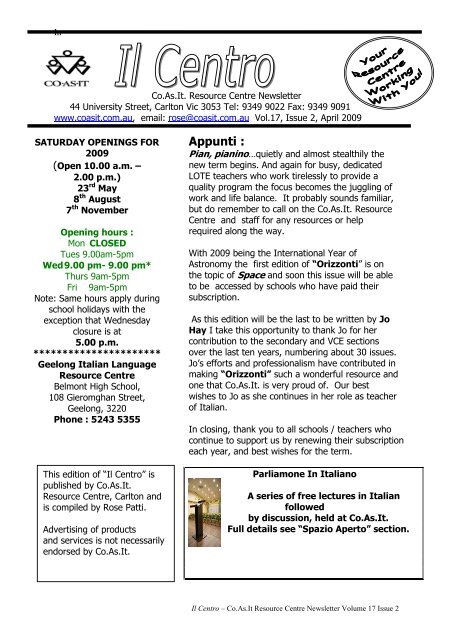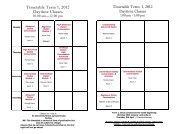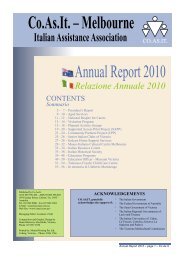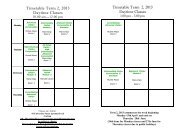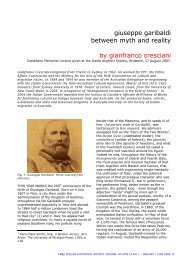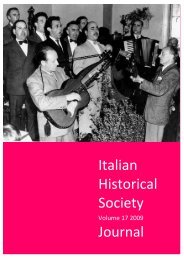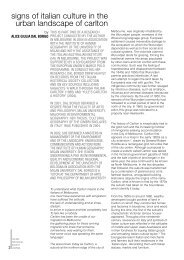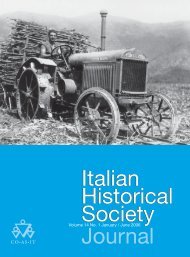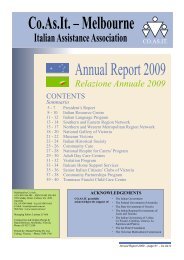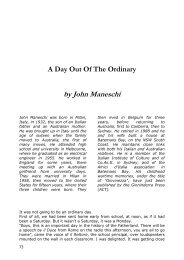Il Centro - Co.As.It
Il Centro - Co.As.It
Il Centro - Co.As.It
You also want an ePaper? Increase the reach of your titles
YUMPU automatically turns print PDFs into web optimized ePapers that Google loves.
In<br />
<strong>Co</strong>.<strong>As</strong>.<strong>It</strong>. Resource Centre Newsletter<br />
44 University Street, Carlton Vic 3053 Tel: 9349 9022 Fax: 9349 9091<br />
www.coasit.com.au, email: rose@coasit.com.au Vol.17, Issue 2, April 2009<br />
SATURDAY OPENINGS FOR<br />
2009<br />
(Open 10.00 a.m. –<br />
2.00 p.m.)<br />
23 rd May<br />
8 th August<br />
7 th November<br />
Opening hours :<br />
Mon CLOSED<br />
Tues 9.00am-5pm<br />
Wed 9.00 pm- 9.00 pm*<br />
Thurs 9am-5pm<br />
Fri 9am-5pm<br />
Note: Same hours apply during<br />
school holidays with the<br />
exception that Wednesday<br />
closure is at<br />
5.00 p.m.<br />
**********************<br />
Geelong <strong>It</strong>alian Language<br />
Resource Centre<br />
Belmont High School,<br />
108 Gieromghan Street,<br />
Geelong, 3220<br />
Phone : 5243 5355<br />
This edition of “<strong>Il</strong> <strong>Centro</strong>” is<br />
published by <strong>Co</strong>.<strong>As</strong>.<strong>It</strong>.<br />
Resource Centre, Carlton and<br />
is compiled by Rose Patti.<br />
Appunti :<br />
Advertising of products<br />
and services is not necessarily<br />
endorsed by <strong>Co</strong>.<strong>As</strong>.<strong>It</strong>.<br />
Appunti :<br />
Pian, pianino…quietly and almost stealthily the<br />
new term begins. And again for busy, dedicated<br />
LOTE teachers who work tirelessly to provide a<br />
quality program the focus becomes the juggling of<br />
work and life balance. <strong>It</strong> probably sounds familiar,<br />
but do remember to call on the <strong>Co</strong>.<strong>As</strong>.<strong>It</strong>. Resource<br />
Centre and staff for any resources or help<br />
required along the way.<br />
With 2009 being the International Year of<br />
<strong>As</strong>tronomy the first edition of “Orizzonti” is on<br />
the topic of Space and soon this issue will be able<br />
to be accessed by schools who have paid their<br />
subscription.<br />
<strong>As</strong> this edition will be the last to be written by Jo<br />
Hay I take this opportunity to thank Jo for her<br />
contribution to the secondary and VCE sections<br />
over the last ten years, numbering about 30 issues.<br />
Jo’s efforts and professionalism have contributed in<br />
making “Orizzonti” such a wonderful resource and<br />
one that <strong>Co</strong>.<strong>As</strong>.<strong>It</strong>. is very proud of. Our best<br />
wishes to Jo as she continues in her role as teacher<br />
of <strong>It</strong>alian.<br />
In closing, thank you to all schools / teachers who<br />
continue to support us by renewing their subscription<br />
each year, and best wishes for the term.<br />
Parliamone In <strong>It</strong>aliano<br />
A series of free lectures in <strong>It</strong>alian<br />
followed<br />
by discussion, held at <strong>Co</strong>.<strong>As</strong>.<strong>It</strong>.<br />
Full details see “Spazio Aperto” section.<br />
<strong>Il</strong> <strong>Centro</strong> – <strong>Co</strong>.<strong>As</strong>.<strong>It</strong> Resource Centre Newsletter Volume 17 Issue 2
Proverbi<br />
From : Mille proverbi italiani : tutto il sapere popolare in una vasta raccolta di massime di saggezza, by<br />
Massimo Baldini, Tascabili Economici Newton, Rome, 1996, & and from the website:<br />
users.libero.it/pncsfn/proverbi<br />
Aiuto :<br />
Amare :<br />
Amico :<br />
Amore :<br />
Appetito :<br />
È meglio un aiuto che cento consigli.<br />
Ogni aiuto è buono.<br />
Amare e non essere amato è tempo perso.<br />
Ama chi t‟ama e rispondi a chi ti chiama.<br />
A chi s‟ama si crede.<br />
Chi non ama non ha cuore.<br />
Chi trova un amico trova un tesoro.<br />
Al bisogno si conosce l‟amico.<br />
L‟amico certo si conosce nell‟incerto.<br />
Vale più un amico che cento parenti.<br />
<strong>Il</strong> primo amore non si scorda mai.<br />
L‟amore è cieco.<br />
L‟appetito vien mangiando.<br />
<strong>As</strong>ino :<br />
Avere :<br />
Ballare :<br />
Barba :<br />
Bellezza :<br />
Bocca :<br />
Bugia :<br />
Cane :<br />
Un asino trova sempre un altro asino che lo ammira.<br />
Chi asino nasce, asino muore.<br />
Chi poco ha, poco dà.<br />
Quando uno è in ballo, deve ballare.<br />
Chi non vuol ballare non vada alla festa.<br />
La barba non fa il filosofo.<br />
Non è bello ciò che è bello, ma è bello ciò che piace.<br />
Onestà e gentilezza sopravanza ogni bellezza.<br />
Non metter bocca dove non ti tocca.<br />
Le bugie hanno le gambe corte.<br />
Una bugia tira l‟altra.<br />
La bugia è come una valanga, più rotola più s‟ingrossa.<br />
Can che abbaia non morde.<br />
Carnevale :<br />
Casa :<br />
Cavallo :<br />
Per carnevale ogni scherzo vale.<br />
La casa e la moglie si godono più d‟ogni altra cosa.<br />
Ognuno è re a casa sua.<br />
Campa cavallo che l‟erba cresce.<br />
<strong>Il</strong> <strong>Centro</strong> – <strong>Co</strong>.<strong>As</strong>.<strong>It</strong> Resource Centre Newsletter Volume 17, Issue 2
<strong>Co</strong>ntadino :<br />
Al contadino non far sapere quanto è buono il formaggio con le pere.<br />
Cuoco :<br />
Cuore :<br />
Debiti :<br />
Troppi cuochi gustano la cucina.<br />
Mano fredda, cuor sincero.<br />
Lontan dagli occhi, lontan dal cuore.<br />
Chi non ha debiti è ricco.<br />
I debiti e i peccati crescono sempre.<br />
Denari :<br />
Chi ha denari da recuperare, molte<br />
gite ha da fare.<br />
I denari vanno e vengono.<br />
Diavolo :<br />
Dio :<br />
Donna :<br />
Dormire :<br />
Erba :<br />
Esempio :<br />
Fare :<br />
Figlia :<br />
<strong>Il</strong> diavolo fa le pentole, ma non i coperchi.<br />
Dio vede e provvede.<br />
Aiutati che Dio t‟aiuta.<br />
Quando Dio chiude una finestra, apre una porta.<br />
Dio li fa e poi li accoppia.<br />
Chi dice donna dice guai.<br />
La donna ha più capricci che ricci.<br />
Donna al volante pericolo costante<br />
Donne e dolori, gioie e dolori.<br />
Chi dorme non piglia pesci.<br />
Chi ha da fare non dorme.<br />
L‟erba del vicino è sempre la più verde.<br />
<strong>Co</strong>ntano più gli esempi che le parole.<br />
Non fare il passo più lungo della gamba.<br />
È meglio fare una cosa che desiderarla fatta.<br />
Fa‟ oggi quello che devi fare domani.<br />
Altro è dire, altro è fare.<br />
Tra il dire e il fare c‟è di mezzo il mare.<br />
Una figlia, una meraviglia.<br />
Fortuna :<br />
Fuoco :<br />
Gatto :<br />
Giocare :<br />
Guerra :<br />
Alla fortuna bisogna lasciar sempre una finestra aperta.<br />
Dove si fa fuoco, nasce del fumo.<br />
Quando il gatto è via i topi ballano.<br />
<strong>As</strong>sai vince chi non gioca.<br />
Chi non vuol perdere non giochi.<br />
La guerra nasce da due parole : “mio” e “tuo”.<br />
Chi va alla guerra mangia male e dorme in terra.<br />
Imparare : Ognuno impara a sue spese.<br />
Vivendo si impara.<br />
Sbagliando si impara.<br />
Non si è mai troppo vecchi per imparare.<br />
<strong>Il</strong> <strong>Centro</strong> – <strong>Co</strong>.<strong>As</strong>.<strong>It</strong> Resource Centre Newsletter Volume 17, Issue 2
Lavoro :<br />
<strong>Il</strong> lavoro nobilita l‟uomo.<br />
Chi si vergogna di lavorare, abbia vergogna di mangiare.<br />
Lavoro fatto di notte non val tre pere cotte.<br />
Libro :<br />
È meglio un libro corretto che bello.<br />
Chi ha libri ha labbra.<br />
Litigare : Tra i due litiganti, il terzo gode.<br />
Chi litiga col muro si rompe la testa.<br />
Male :<br />
Non tutto il male vien per nuocere<br />
Meglio soli che male accompagnati<br />
Marito : Chi si marita male, non fa mai carnevale.<br />
Meglio il marito senza amore che con gelosia.<br />
Matrimonio : Se il matrimonio durasse un anno, tutti si mariterebbero.<br />
Nel matrimonio un mese di miele il resto di fiele.<br />
Mestiere : Ognuno parla bene del suo mestiere.<br />
Tutti i mestieri danno pane.<br />
Moglie :<br />
Mondo :<br />
Notte :<br />
Nulla :<br />
Oro :<br />
Ozio :<br />
Papa :<br />
Parola :<br />
Moglie e buoi dei paesi tuoi.<br />
Tra moglie e marito non mettere il dito.<br />
Tutto il mondo è paese.<br />
<strong>Il</strong> mondo è bello perchè è vario.<br />
La notte porta consiglio<br />
Di notte tutti i gatti sono neri.<br />
È meglio qualcosa che nulla.<br />
<strong>Co</strong>l nulla si fa nulla.<br />
L‟oro non compra tutto.<br />
Non è tutto oro quel che luccica.<br />
L‟ozio è il padre di tutti i vizi.<br />
Alla gente oziosa non manca mai scuse.<br />
Morto un papa se ne fa un altro.<br />
Le parole non fanno fatti.<br />
Pazienza : <strong>Co</strong>n la pazienza si vince tutto.<br />
La pazienza è la virtù dei santi.<br />
Pensare :<br />
Pensa oggi e parla domani.<br />
Povero :<br />
I poveri non hanno parenti.<br />
<strong>Il</strong> <strong>Centro</strong> – <strong>Co</strong>.<strong>As</strong>.<strong>It</strong> Resource Centre Newsletter Volume 17, Issue 2
Povertà :<br />
Chi cade in povertà perde ogni amico.<br />
Promettere : Promettere è una cosa e mantenere un‟altra.<br />
Ragione :<br />
Chi ha meno ragione grida più forte.<br />
Sapere :<br />
<strong>Il</strong> sapere è il bastone della vita.<br />
Chi non sa niente, non è buono a niente.<br />
Chi troppo sa, poco sa.<br />
È bene sapere un po‟ di tutto.<br />
Speranza : Finchè c‟è vita, c‟è speranza.<br />
La speranza è sempre l‟ultima a morire.<br />
Strada :<br />
Strada buona non fu mai lunga.<br />
Tutte le strade portano a Roma.<br />
Superbia : La superbia mostra l‟ignoranza.<br />
Quando la superbia sale, l‟amicizia scende.<br />
Tempo (Time) : <strong>Il</strong> tempo vince tutto.<br />
<strong>Il</strong> tempo è galantuomo.<br />
<strong>Il</strong> tempo consume ogni cosa.<br />
Tempo (Weather) : Rosso di sera bel tempo si spera.<br />
Rosso di mattina la pioggia si avvicina.<br />
Umilità :<br />
Uomo :<br />
Vestiti :<br />
Vicino :<br />
Vizio :<br />
Volere :<br />
L‟umiltà è la corona di tutte le virtù.<br />
Senza l‟umiltà tutte le virtù son vizi.<br />
Uomo avvisato, mezzo salvato.<br />
I vestiti il primo anno si portano per amore e il secondo per forza.<br />
L‟abito non fa il monaco.<br />
La vicinanza è mezza parentela.<br />
<strong>Il</strong> lupo perde il pelo, ma non il vizio.<br />
Volere è potere.<br />
Chi troppo vuole niente stringe<br />
Chi va con lo zoppo impara a zoppicare.<br />
Chi tardi arriva male alloggia.<br />
Chi la dura la vince<br />
Fidarsi è bene ma non fidarsi è meglio.<br />
Chi cerca trova.<br />
Altri proverbi conosciuti:<br />
<strong>Il</strong> <strong>Centro</strong> – <strong>Co</strong>.<strong>As</strong>.<strong>It</strong> Resource Centre Newsletter Volume 17, Issue 2
„Migration ! Migration !‟ 1 and 2<br />
For Primary and Secondary students<br />
Available on Mondays – and by arrangement on some Tuesdays and Thursdays.<br />
The 2 separate courses are aimed at Year 4-11 students and are presented in either<br />
English or <strong>It</strong>alian. <strong>Co</strong>urse 1 is a general introduction. <strong>Co</strong>urse 2 focuses on problems<br />
and solutions.<br />
The presentation lasts about 1 hour with interactive / problem-solving activities.<br />
The course is based on VELS and covers a number of strands, domains and dimensions.<br />
The program makes use of photographs and objects from the <strong>It</strong>alian Historical Society.<br />
<strong>Co</strong>st: $44.00 per class / per course including GST ($66.00 for non-members). Fees for<br />
visits to outer suburban schools are available upon application.<br />
Teachers will receive a free activities kit. The kit is not available separately.<br />
Upon receipt of remittance the kit is sent to schools so that the pre-visit activities can be<br />
completed.<br />
Although focusing on <strong>It</strong>alian migration to Australia, general immigration issues are<br />
included. This helps to engage new migrant students and develop skills of comparison<br />
and promote acceptance and tolerance.<br />
* Select a date and time – allow for travel.<br />
TO BOOK<br />
* <strong>Co</strong>ntact Nicolas Panayotis, Secondary Schools Adviser, at nic@coasit.com.au or on<br />
9349 9019 on Mondays. If leaving a message please leave name, school name and<br />
telephone and a mobile number.<br />
* Do not send payment until date and time have been confirmed. Then fill in the form and<br />
attach to your remittance. A receipt will be provided on in-service day.<br />
<strong>Il</strong> <strong>Centro</strong> – <strong>Co</strong>.<strong>As</strong>.<strong>It</strong> Resource Centre Newsletter Volume 17, Issue 2
BOOKING FORM AND TAX INVOICE FOR<br />
IMMIGRATION 1 and / or 2 PRESENTATION<br />
ABN 85 005 596 485<br />
SCHOOL AND TEACHER DETAILS<br />
School Name: ______________________________________________________________________<br />
Address: ______________________________________________________________________<br />
______________________________________________________________________<br />
_________________________________________ Postcode: _________________<br />
Telephone: ___________________ Other contact number: (essential) ______________________<br />
e-mail: ______________________________________________________________________<br />
CLASS DETAILS<br />
Name of accompanying teacher/s: ______________________________________________________<br />
Class level: _________________________ Number of students: ____________________________<br />
Presentation 1 or 2 ? ________________________________________________________________<br />
Language of presentation required: ___________________________________________________<br />
PREFERRED DATE AND COST<br />
Preferred dates of in-service – Mondays – some bookings can be taken on Tuesdays and Thursdays<br />
________________________________________ (Please ring first if not a Monday session)<br />
*** <strong>Co</strong>st: $44.00 per class, including GST and a copy of the kit. ($66.00 for non-members)***<br />
This form and remittance must accompany all bookings<br />
Any enquiries – nic@coasit.com.au / 9349 9019<br />
Cheques made out to <strong>Co</strong>.<strong>As</strong>.<strong>It</strong>. - $44.00 per class – incl GST ($66.00 for non-members)<br />
Address envelope to:<br />
Carlton 3053<br />
Nicolas Panayotis<br />
<strong>Co</strong>.<strong>As</strong>.<strong>It</strong>. – 189 Faraday Street<br />
Payment should reach us 7 days prior to session<br />
10% late and cancellation fees apply<br />
<strong>Il</strong> <strong>Centro</strong> – <strong>Co</strong>.<strong>As</strong>.<strong>It</strong> Resource Centre Newsletter Volume 17, Issue 2
PARLIAMONE IN ITALIANO<br />
<strong>Co</strong>.<strong>As</strong>.<strong>It</strong>.,Melbourne, in collaboration with The <strong>It</strong>alian Institute of Culture and the <strong>Co</strong>nsul General<br />
of <strong>It</strong>aly in Melbourne presents a series of monthly lectures in <strong>It</strong>alian, followed by general discussion.<br />
The evening will begin at 7.00 p.m. and will conclude at 8.30 p.m. in<br />
Grollo Theatre<br />
199 Faraday Street, Carlton<br />
(Melway 2B G7; 43 J4)<br />
Free admission with limited seating<br />
R.S.V.P. essential<br />
For booking phone 9349 9022 or email claudiam@coasit.com.au<br />
Wednesday 29 th April, 2009<br />
7.00p.m. - 8.30p.m.<br />
Wednesday 27th May,2009<br />
7.00p.m. - 8.30p.m.<br />
Wednesday 24th June,2009<br />
7.00p.m. - 8.30p.m.<br />
Wednesday 29th July, 2009<br />
6.30pm – 8.30p.m.<br />
Wednesday 26 th August, 2009<br />
7.00p.m. - 8.30p.m.<br />
Wednesday 30 th September, 2009<br />
7.00p.m. - 8.30p.m.<br />
Wednesday 28th October,2009<br />
Mr. Piero Genovesi<br />
Managing Director, <strong>It</strong>alian Australian Institute Research Centre,<br />
La Trobe University<br />
“La repubblica della parola.<br />
L‟editoria d‟assalto degli anni 50 – 60”<br />
Ms. Adriana Diomedi<br />
Dante Alighieri Society, Melbourne<br />
“Amore – La voce dell‟anima”<br />
Mr. Stefano Fossati<br />
Director, <strong>It</strong>alian Institute of Culture, Melbourne<br />
“Souvenir indirizzi -yoga, tantra, Harikrishna e altri contributi<br />
dell'India alla formazione della moderna sensibilita' religiosa<br />
italiana”<br />
Ms. Susanna Scarparo<br />
Senior Lecturer, <strong>Co</strong>nvenor of <strong>It</strong>alian Studies<br />
Monash University<br />
“Le donne negli anni 60 e 70” Proiezione del film “Vogliamo<br />
anche le rose” di Alina Marazzi<br />
Mr. Michele Pedrolo<br />
Lecturer, La Trobe University<br />
“D‟amore e di altre sciocchezze.<br />
I cantautori tra impegno e poesia”<br />
Dr. Mirna Cicioni<br />
Honorary Research <strong>As</strong>sociate in <strong>It</strong>alian Studies<br />
Faculty of Arts, Monash University<br />
“Clara Sereni: una donna scrive di storia,<br />
di cibo e di sé ”<br />
Ms. Michela Betta<br />
<strong>Il</strong> <strong>Centro</strong> – <strong>Co</strong>.<strong>As</strong>.<strong>It</strong> Resource Centre Newsletter Volume 17, Issue 2
7.00p.m – 8.30p.m.<br />
Wednesday 25 th November,2009<br />
7.00p.m. - 8.30p..m<br />
Author<br />
Senior lecturer at Swinburne University<br />
“L‟etica di Machiavelli. Una rivisitazione dei concetti<br />
fondamentali de <strong>Il</strong> Principe”<br />
Mr. Mimmo Mangione.<br />
“<strong>Il</strong> linguaggio del teatro nella <strong>Co</strong>mmedia dell‟Arte”<br />
*********************************************************************************************************<br />
The Old Macaroni Factory, Hepburn Springs 1859 – 2009<br />
Calendar of Events<br />
150 th Celebrations in 2009<br />
Hepburn Springs and Australia’s Spa capital will be under the spotlight in 2009 when Australia’s oldest<br />
<strong>It</strong>alian building celebrates 150 years! Celebrations focus on bringing the families of original settlers and historylovers<br />
back to the picturesque village, once known as Spring Creek…to reflect and celebrate the gold<br />
prospecting that brought so many Swiss and <strong>It</strong>alians and other nationalities to the region, the finding of mineral<br />
water and the establishment of Australia’s first macaroni factory….<br />
Further Events in the Year<br />
• Melbourne <strong>It</strong>alian Festa comes to Hepburn Springs : Little <strong>Co</strong>rner of <strong>It</strong>aly 24 May – 7 June<br />
Celebrations include <strong>It</strong>alian Republic Day Tuesday 2 June<br />
With <strong>Co</strong>mmunity celebrations at Hepburn Springs venues, lunches and <strong>It</strong>alian family history talks<br />
• The Lucini Stories : Words in Winter Festival August 2009 : Saturday 1 & Sunday 2 August<br />
• Hepburn Springs <strong>Co</strong>medy Festa Saturday 19 & Sunday 20 September<br />
• Swiss <strong>It</strong>alian Festa (moved from April to October) 9 – 18 October<br />
• Geranium and Herb Festa Sunday 15 November 2009<br />
For full details, cost and booking information contact :<br />
(03) 5348 4345<br />
0400 854 029 (Maria)<br />
0404 123 153 (Matt)<br />
www.macaronifactory.com.au<br />
mariaviola@bigppond.com<br />
<strong>Il</strong> <strong>Centro</strong> – <strong>Co</strong>.<strong>As</strong>.<strong>It</strong> Resource Centre Newsletter Volume 17, Issue 2
ITALIAN CARLTON<br />
The program <strong>It</strong>alian Carlton explores the experiences and contributions made by the <strong>It</strong>alian<br />
community to Carlton, making this multicultural suburb what it is today.<br />
<strong>It</strong>alian Carlton is supported by <strong>Co</strong>.<strong>As</strong>.<strong>It</strong>, Museum Victoria and the Ian Potter Foundation for secondary<br />
students Year 7-12 of <strong>It</strong>alian or History. Students begin the experience with a self guided walk in the<br />
Carlton precinct with accompanying activities based on the principles of ILTLP( Intercultural Language<br />
Teaching and Learning Practice Project) and later they explore historical Carlton via the interactive<br />
website <strong>It</strong>alian Carlton.<br />
Exploration of the website <strong>It</strong>alian Carlton takes place in the computer lab at <strong>Co</strong>.<strong>As</strong>.<strong>It</strong>, where students<br />
can explore the themes of Food, Entertainment, History, Fashion & <strong>Co</strong>mmunity Celebrations, and use<br />
an interactive map to tour the Carlton precinct past and present. Key stories of <strong>It</strong>alians that<br />
contributed to the area are also presented as part of the experience.<br />
Students undertake online activities that represent the VELS domains of History & LOTE (<strong>It</strong>alian) and<br />
ICT that allows them to research <strong>It</strong>alian Carlton past and present. The website <strong>It</strong>alian Carlton is<br />
presented in English and <strong>It</strong>alian. The teacher may choose for students to undertake the study in<br />
English or <strong>It</strong>alian depending on the focus.<br />
The original owners of Toto‟s Pizza House.<br />
Borsari Ristorante on Lygon Street.<br />
Location: <strong>Co</strong>.<strong>As</strong>.<strong>It</strong>, 189 Faraday Street, Carlton (entry at University Street via <strong>Co</strong>.<strong>As</strong>.<strong>It</strong> Resource<br />
Centre)<br />
<strong>Co</strong>st of program: $66.00 per class that includes self guided materials and research time in the<br />
<strong>Co</strong>.<strong>As</strong>.<strong>It</strong> computer lab. Maximum number 24 students per session. The program can be delivered in<br />
English or <strong>It</strong>alian by Rosaria Zarro, <strong>Co</strong>.<strong>As</strong>.<strong>It</strong> Education Officer at Museum Victoria.<br />
Dates available: Thursdays and Fridays in Term 2, 2008<br />
Times: 10 am & 11.30 am<br />
Duration:<br />
Introduction to <strong>It</strong>alian Carlton 5-10 minutes at <strong>Co</strong>.<strong>As</strong>.<strong>It</strong>, Carlton.<br />
Walk around Carlton precinct 30-40 minutes- self guided activities provided on the day. ICT activity in<br />
<strong>Co</strong>.<strong>As</strong>.<strong>It</strong> computer lab 40 minutes Total visit: 90 minutes<br />
<strong>Il</strong> <strong>Centro</strong> – <strong>Co</strong>.<strong>As</strong>.<strong>It</strong> Resource Centre Newsletter Volume 17, Issue 2
ITALIAN CARLTON<br />
BOOKING FORM AND INVOICE FOR<br />
<strong>It</strong>alian Carlton program<br />
<strong>Co</strong>.<strong>As</strong>.<strong>It</strong> ABN 85 005 596 485<br />
SCHOOL AND TEACHER DETAILS<br />
School Name: ______________________________________________________________<br />
Address:_______________________________________________________<br />
______________________________________________________________<br />
Post code: __________________________<br />
Telephone: __________________________<br />
Email: ______________________________________________________________<br />
CLASS DETAILS<br />
Name of accompanying teacher / teacher in charge:<br />
_________________________________________<br />
Class level: ____________________<br />
Number of students: __________<br />
Are any of the students studying <strong>It</strong>alian? ________________________________________________<br />
Do you prefer the program to be presented in <strong>It</strong>alian or English?<br />
Preferred date & day of program visit (see information page for dates and days)<br />
___________________________________________________________________<br />
Time of program circle preference 10am 11.30am (allow at least 90 minutes):<br />
Cheque for $66 enclosed Yes/No<br />
Cheques made out to <strong>Co</strong>.<strong>As</strong>.<strong>It</strong>. address envelope to :<br />
Rosaria Zarro, <strong>Co</strong>.<strong>As</strong>.<strong>It</strong> Education Officer 189 Faraday Street, Carlton,<br />
3053 include this booking form with cheque.<br />
Any queries- Email: Rosaria Zarro- rzarro@museum.vic.gov.au or<br />
telephone: 8341-7316 fax: 8341- 722<br />
<strong>Il</strong> <strong>Centro</strong> – <strong>Co</strong>.<strong>As</strong>.<strong>It</strong> Resource Centre Newsletter Volume 17, Issue 2
ORDER FORM AND TAX INVOICE FOR<br />
„Migration Migration‟ laminated posters<br />
ABN 85 005 596 485<br />
SCHOOL AND TEACHER DETAILS<br />
School Name: ______________________________________________________________<br />
Address: ______________________________________________________________<br />
_________________________ Post code: ____________________<br />
Telephone: _________ Other contact number: ______________________________<br />
e-mail: _____________________________________________________________<br />
DETAILS<br />
Set of 14 laminated posters: 12 x A3 size / 2 X A4 size –<br />
b & w. photos of the <strong>It</strong>alian Historical Society<br />
COST<br />
$33.00 per set including GST + $7.00 postage<br />
PAYMENT<br />
• Cheques only, please<br />
• Made out to <strong>Co</strong>.<strong>As</strong>.<strong>It</strong>.<br />
• Payment is required within 14 days of invoice<br />
• Late payment will incurr a 10% surcharge<br />
METHOD<br />
• Address envelope to Nicolas Panayotis<br />
c/- <strong>Co</strong>.<strong>As</strong>.<strong>It</strong>.<br />
189 Faraday Street<br />
Carlton 3053<br />
• Please give a copy of form to accountant to include with payment<br />
• Please ring 9349 9019 if there are incorrect details and leave a message<br />
• Quote the reference number<br />
Thank you and ‘buon lavoro’<br />
See sample picture !<br />
Originals may be viewed at <strong>Co</strong>.<strong>As</strong>.<strong>It</strong>.<br />
<strong>Il</strong> <strong>Centro</strong> – <strong>Co</strong>.<strong>As</strong>.<strong>It</strong> Resource Centre Newsletter Volume 17, Issue 2
NEW PRIMARY SCHOOL SHOW FROM TERM 2 2009<br />
LA COMICA VARIETY<br />
PRESENTS<br />
NEW PRIMARY SCHOOL SHOW<br />
“RISTORANTE MANGIABANANE”<br />
HIGH SCHOOL SHOW’S<br />
“TRATTORIA MANGIABANANE”<br />
&<br />
WOG FM<br />
PRIMARY SCHOOL SHOW OPEN FOR GRADES PREP TO 6<br />
HIGH SCHOOL SHOW‟S OPEN FOR YEARS 7 TO 12<br />
A great way to enjoy learning ITALIAN as their LOTE.<br />
.<br />
La <strong>Co</strong>mica Variety is taking bookings NOW!<br />
Call James anytime on 0409 932 014<br />
for quotes, bookings or to be sent out an information package.<br />
Email: jliotta@telstra.com<br />
Arcobaleno on CD<br />
For schools who are current subscribers available at $5.00 for each of the 8 Theme Packs<br />
plus $6.00 postage : Total $46.00<br />
For schools who are not current subscribers the cost is $22.00 for each of the 8 Theme<br />
Packs plus $6.00 postage : Total $182.00<br />
See Tax Invoice at the end of this Newsletter<br />
Tax Claim for visiting <strong>Co</strong>.<strong>As</strong>.<strong>It</strong>.<br />
Teachers are eligible to claim their travelling costs to and from <strong>Co</strong>.<strong>As</strong>.<strong>It</strong>. Resource Centre.<br />
<strong>It</strong> is good practice to retain the print log of items borrowed which includes the date and<br />
subsequently presents a claim for taxation purposes.<br />
Please consult with your tax agent regarding this matter.<br />
<strong>Il</strong> <strong>Centro</strong> – <strong>Co</strong>.<strong>As</strong>.<strong>It</strong> Resource Centre Newsletter Volume 17, Issue 2
Picard Series : Tommaso e Clara by<br />
Margaret Clancy, LOTE Teaching Aids, Australia, 2006.<br />
These books have simple speech with familiar words<br />
that children can enjoy and read without assistance.<br />
These books are an excellent resource to encourage<br />
children to read and enjoy books without assistance.<br />
Titles in the series include : La famiglia, Saluti, Età e<br />
nomi, Numeri e colori and I giorni e il tempo.<br />
Easy <strong>It</strong>alian : Step-by-Step by Paola Nanni-Tate,<br />
McGraw Hill, Sydney, 2009.<br />
This book features a unique “building block” approach<br />
to mastering essential grammar, verbs, and vocabulary<br />
and practical explanations of important rules and<br />
concepts with hundred of frequently used verbs and<br />
key terms a beginner should know. Includes exercises<br />
to test and measure progress. Suitable for high<br />
Intermediate / Advanced Students.<br />
Benvenuti in <strong>It</strong>aliano : corso modulare di lingua<br />
<strong>It</strong>aliana per ragazzi, Volume 1 & 2, by Marcello<br />
Silvestrini and Graziella Novembri, Guerra<br />
Edizioni, 2005.<br />
The variety of text types presented in this book are<br />
authentic and interesting. Often repeated topics such<br />
as greetings, the weather, food and clothing are reinvented<br />
and re-energized. Grammar is outlined<br />
regularly and contemporary photographs enhance the<br />
texts. Suitable for upper primary and lower secondary.<br />
Traffico in centro by Marco Dominici,<br />
Primiracconti Series, Edilingua, Rome, 2007<br />
This series of easy readers is supplemented by<br />
a Cd, brief notes to explain more difficult words<br />
and phrases and comprehension and oral activities.<br />
An answer key at the end of the novel enables<br />
students to self-correct.<br />
Stories are graded for beginner and intermediate<br />
students.<br />
<strong>Il</strong> <strong>Centro</strong> – <strong>Co</strong>.<strong>As</strong>.<strong>It</strong> Resource Centre Newsletter Volume 17, Issue 2
<strong>It</strong>alians First! From A to Z by Arturo Barone<br />
A celebration of some major and minor achievements that absolutely everyone should know<br />
– including the <strong>It</strong>alians!<br />
Everybody knows that the <strong>It</strong>alians invented spaghetti, pizza, Ferrari cars and “la dolce vita”.<br />
But what about the hundreds of other <strong>It</strong>alian “first” that have added to the quality of life and<br />
the advance of civilisation, or just generally helped make the world go round? For the sake of<br />
completeness, it is worth adding the following to any list of famous <strong>It</strong>alians.<br />
Architecture & Buildings<br />
• In 1432 Filippo Brunelleschi (born in Florence) developed the concept of the<br />
negative side thrust and designed and built the dome on the Florence Duomo.<br />
Closer to home, the dome on the Exhibition Buildings, Carlton was modelled on the<br />
Florence Cathedral.<br />
• In 1570, Andrea Palladio (born in Padua) published his four books “On Architecture”<br />
which were translated into all modern languages. His style was easily assimilated in<br />
England and influenced all subsequent English architects including Sir Christopher<br />
Wren. There is still in existance a copy of Palladio‟s work signed by Lord Burlington<br />
and dated by him 1728.<br />
• <strong>It</strong> is San Gimignano in Tuscany, not New York, which boasts the first skyscrapers in<br />
the world. Known as “tower houses”, they were built in about 1200 when San<br />
Gimignano came under the dominance of the Etruscan town Volterra. According to<br />
existing records, about 76 of these towers were built, but only 13 are left standing<br />
today.<br />
Gastronomy : In all maters of food the <strong>It</strong>alians have given a lead.<br />
• In the Renaissance, <strong>It</strong>alian cooking was the turning point in the development of<br />
gastronomic excellence. <strong>It</strong>aly influenced France intensively.<br />
• <strong>It</strong> was Catherine de’ Medici who brought <strong>It</strong>alian cooking to France when she married<br />
Henry II of Navarre and took with her to France a retinue of <strong>It</strong>alian cooks.<br />
• The fork for dining was invented in <strong>It</strong>aly in the sixteenth century. <strong>It</strong> came into use in<br />
England about 100 years later.<br />
• <strong>It</strong> was the Venetian traders who introduced coffee to <strong>It</strong>aly and Europe circa the year<br />
1615. <strong>Co</strong>ffee appears to have originated in Abyssinia and then spread by the Arabs to<br />
the Balkans, Spain, India, North Africa and Turkey.<br />
• In 1592, in Venice, Prospero Alpini, a botanist at Padua University, published the first<br />
recorded description in the western world of both the coffee plant and the drink in his<br />
treatise The Plants of Egypt.<br />
• Venice also claims another first, namely the establishment of the first coffee house in<br />
the western world in 1645.<br />
• The first espresso coffee machine was invented in 1946 by Gaggia of Milan.<br />
• <strong>It</strong> was in Naples, in 1800, that pasta was first mechanically produced and the first<br />
factory of pasta so manufactured was built at Sansepolcro in 1827 by Buitoni.<br />
• Alcohol was first distilled at the Salerno School of Medicine in the year 1000. Large<br />
scale production of alcohol, however, is recorded for the first time at Modena in the<br />
thirteenth century.<br />
• The recipe for milk ices originates in the Far East. <strong>It</strong> was recorded by Marco Polo<br />
during one of his travels in China and was brought back to Europe by him.<br />
<strong>Il</strong> <strong>Centro</strong> – <strong>Co</strong>.<strong>As</strong>.<strong>It</strong> Resource Centre Newsletter Volume 17, Issue 2
• Charles I of England was particularly appreciative of the milk ices prepared by his<br />
<strong>It</strong>alian cook, Mireo, and it is claimed that his <strong>It</strong>alian wife, Enrichetta Maria Medici,<br />
and her said cook introduced ice-cream into Britain.<br />
• In 1896 <strong>It</strong>alo Marcioni, an <strong>It</strong>alian immigrant to New Jersey, USA, created the first icecream<br />
cone.<br />
• No history of pizza would be complete without the classic story of the pizza<br />
Margherita. Modern pizza history was made in 1889 when Queen Margherita Teresa<br />
Giovanni, the consort of Umberto I, visited Naples with her king. Don Raffaele<br />
Esposito, who owned Pietro <strong>Il</strong> Pizzaiolo, was asked to prepare a special dish in honour<br />
of the Queen's visit. Esposito consulted his wife who was the real pizza expert and<br />
together they developed a pizza featuring tomatoes, mozzarella cheese, and basil. He<br />
named it the Margherita Pizza, after the city's guest of honor.<br />
Manners<br />
• In the year 1513 Baldassarre Castiglione (born at Casatico) wrote <strong>Il</strong> <strong>Co</strong>rtegiano. <strong>It</strong><br />
was a book that was to have an enormous impact upon England. <strong>It</strong> was the first book<br />
of manners but also dealt with the relationship between the courtesan and the prince<br />
and it was used by young members of the English establishment until the days of<br />
Edward VII as their bible on manners.<br />
• In 1550 Giovanni Della Casa (born in Mugello) wrote <strong>Il</strong> Galateo, the first etiquette<br />
manual.<br />
• The handkerchief was invented in <strong>It</strong>aly during the Renaissance.<br />
• Eau-de-<strong>Co</strong>logne was invented by Giovanni Farina. He was born in 1685 in southern<br />
<strong>It</strong>aly and in 1709 he settled in <strong>Co</strong>logne in Germany where he reproduced certain<br />
experiments that he had been carrying out in his home town of Reggio Calabria. He<br />
based the scent on the essence of bergamot.<br />
Ballet : While it may have been looked upon that ballet was a Russian development as Luigi<br />
Barzini said, it was the <strong>It</strong>alians who taught dancing to the Russians.<br />
• In 1400 Domencio da Piacenza wrote his first book on the dances of Europe. <strong>It</strong> was,<br />
written, as was then customary, in the Latin language and it was called De Arte<br />
Saltandi Et Choreas Ducendi.<br />
• The first ballet was produced by Baltazarini Di Belgioioso. <strong>It</strong> is not clear whether he<br />
did so in Tortona in <strong>It</strong>aly in 1489, or in France in 1581.<br />
• <strong>It</strong> was Salvatore Viganò (born in Naples) who really established dramatic ballet in<br />
Milan in 1809.<br />
• At about the same time, Gasparo Angiolini (born in Naples) was the first to integrate<br />
dance music and plot.<br />
• In 1591 the term “balletto” was used for the first time by Giovanni Gastoldi.<br />
• In 1747 Gaetano Vestris (born in Florence) established himself as the first male ballet<br />
dancer. In his day, he was referred to as the god of the dance.<br />
• In 1820 Enrico Blasis (born in Naples) codified the techniques of classical ballet.<br />
• In 1887 Enrico Cecchetti (born in Rome) developed his method of training for<br />
dancers which is still widely used throughout the world and is known as Cecchetti’s<br />
Method.<br />
• In 1893 Pierina Legnani established her virtuoso ballet technique which formed the<br />
basis for the Russian School of Ballet.<br />
<strong>Il</strong> <strong>Centro</strong> – <strong>Co</strong>.<strong>As</strong>.<strong>It</strong> Resource Centre Newsletter Volume 17, Issue 2
Music and Musical Instruments<br />
• In 1028 Guido D’Arezzo established the western system of notation based on eight<br />
notes in an octave which is still used extensively throughout the western world despite<br />
attempts by Schoenberg and others to upstage it with a 12-note system. D‟Arezzo is<br />
said to have produced his system while in the Benedictine Abbey at Pomposa, on the<br />
Adriatic.<br />
• In 1634 Francesco Landini established the cadence that bears his name.<br />
• In 1490 the „frottola‟ came into existence as the predecessor of the madrigal.<br />
• In 1492, whilst Christopher <strong>Co</strong>lumbus was travelling to the Indies, Franchino Griffori<br />
first described tuned glasses.<br />
• Around the year 1500 the first thin-cased harpsichord construction was achieved in<br />
<strong>It</strong>aly.<br />
• Afranio (of Pavia) was a Canon at the cathedral in Ferrara and is said to have<br />
invented the bassoon.<br />
• During the Renaissance, the violin evolved in <strong>It</strong>aly.<br />
• In the sixteenth and seventeenth centuries the first virginals and spinets were built in<br />
<strong>It</strong>aly.<br />
• In 1520 Andrea Gabriele (born in Venice) established the procedures that were later<br />
to result in the sonata and started the western system of orchestration.<br />
• In 1597 Ottavio Rinuccini (born in Florence) wrote his Dafne, thus becoming the first<br />
musician to use a libretto.<br />
• In 1600 Agostino Agazzari (born in Siena) wrote the earliest known musical<br />
instruction book.<br />
• The oratorio originated in <strong>It</strong>aly.<br />
• In 1607 Girolamo Frescobaldi (born in Ferrara) established himself as the first<br />
master of organ composition.<br />
• In 1617 Biagio Marini (born in Brescia) wrote the first sonata for solo violin.<br />
• In 1622 Salomone Rossi wrote the first specification of instruments for dance sets.<br />
• In 1698 Bartolomeo Cristofori (born in Padova) constructed the first pianoforte.<br />
• Around the year 1700 the modern violin was first manufactured in <strong>It</strong>aly. <strong>It</strong>s principal<br />
makers were Gasparo Da Salò, Andrea Amati and Giovanni Paolo Maggini. A few<br />
years later they were joined by the maker of the Rolls Royce of violins, namely<br />
Antonio Stradivario (born in Cremona).<br />
Telephones<br />
• In 1871 Antonio Meucci (born in Florence) applied for a patent for what was to<br />
become the telephone. The application of Alexander Graham Bell was lodged in 1876<br />
and Edison‟s carbon refinement is dated 1877. (There was litigation in the American<br />
Supreme <strong>Co</strong>urt between Meucci and Bell and there is no doubt that from the strictly<br />
legalistic point of view Bell was entitled to succeed because the provisional patent<br />
granted to Meucci had expired in 1873, But Meucci got there at least five years before.)<br />
• In 1886 Giovan Battista Marzi (born in Rome) installed and operated for three years<br />
an automatic telephone exchange (with ten lines) in the Vatican City. Although the<br />
number of users was very limited, this was the world‟s first system of automatic<br />
selection. <strong>It</strong> ceased working in 1890 but nevertheless it anticipated the automatic<br />
exchange at Laporte, USA by six years.<br />
Motor Cars<br />
<strong>Il</strong> <strong>Centro</strong> – <strong>Co</strong>.<strong>As</strong>.<strong>It</strong> Resource Centre Newsletter Volume 17, Issue 2
• In 1775 Alessandro Volta (born in <strong>Co</strong>mo) created the electro-phorus, a device to<br />
generate static electricity. He followed this up in 1800 when he invented the first electric<br />
“pile” which was the forerunner of the battery.<br />
• In 1802 Giandomencio Romagnosi (born in Salsomaggiore) observed the magnetic<br />
effect of electric currents.<br />
• In 1858 the experiments of Romagnosi were followed up by Giovanni Pacinotti<br />
who invented the dynamo (he also happens to have invented one of the very first<br />
parachutes.)<br />
• In 1884 Giuseppe Pirelli (born in <strong>Co</strong>mo) made the first electric cable. In 1889 the<br />
same Pirelli made the first motor car tyre.<br />
• In about 1800 Giovanni Battista Venturi (born at Bibiano Reggio Emilia.) invented<br />
the Venturi meter to compute flow volume. At the same time, he anticipated the<br />
carburettor. The carburetion system based on the Venturi principle is used in motor cars,<br />
airplanes, and wherever motor engines are installed.<br />
• The first motorway was the <strong>It</strong>alian “Autostrada”. <strong>It</strong> ran between Milan and Varese,<br />
was inaugurated in 1924 and would later connect Turin and Venice.<br />
Textile Industry<br />
• The textile industry was born in Sicily in 1130 (despite the fact<br />
that the first crepe textiles were manufactured in Bologna around the year<br />
1000 AD). Tuscany followed in 1226: by the middle of the sixteenth century<br />
Genoa and Venice had come to the forefront. Later France took over as<br />
leading producer.<br />
• In 1339 the technique of <strong>It</strong>alian needlepoint was first applied in<br />
Venice. This "punto in aria" was the springboard for the used of<br />
needlepoint around the world.<br />
• Up to the seventeenth century velvet was made exclusively in <strong>It</strong>aly.<br />
• The interplay between <strong>It</strong>aly and France is historic. Throughout<br />
history there have been a number of fields where <strong>It</strong>aly has started a fashion<br />
and France has taken it over, improved on it and subsequently established<br />
itself as master in that particular field. Such interplay is recorded by<br />
Shakespeare when he differentiates between the two countries in the Merchant<br />
of Venice ( Act 1, Scene 2, line 80): "He bought his doublet in <strong>It</strong>aly, his<br />
round hose in France.”<br />
• In 1884 Gaetano Bonelli (born in Turin) invented the first electric loom.<br />
Spectacles (Eye Glasses)<br />
• Eyeglasses first appeared in Pisa in 1291. Their invention is attributed to one<br />
Alessandro Spina from Florence, a Dominican monk who first used convex lenses to<br />
cure myopia.<br />
• In 1352 Tommaso da Modena was the first painter to depict spectacles.<br />
• In 1480, Ghirlandaio depicted Saint Jerome using an eyeglass. (Saint Jerome is the<br />
patron saint of the London Guild of Spectacle Makers.)<br />
Theatre and Acting<br />
• Acting can be said to have started in <strong>It</strong>aly with the <strong>Co</strong>mmedia Dell’Arte in 1545. The<br />
commedia Dell‟Arte lasted well into the eighteenth century.<br />
• The <strong>Co</strong>mmedia Dell‟Arte became famous throughout Europe and was the first troupe<br />
to go “on tour.”<br />
<strong>Il</strong> <strong>Centro</strong> – <strong>Co</strong>.<strong>As</strong>.<strong>It</strong> Resource Centre Newsletter Volume 17, Issue 2
• In 1513 there were erected in the town of Urbino the first three-dimensional structures<br />
on stage.<br />
• In 1520 Angelo Beolco otherwise known as Ruzzante (born in Padova) organised<br />
one of the earliest professional troupes.<br />
• To Beolco‟s company we owe another first, namely, the first theatrical contract with its<br />
member which listed the discipline which he had set up, the organization of the troupe<br />
and the rights and duties of the members. This was a novelty for the time although in<br />
later years it became common practice.<br />
• In 1537 Sebastiano Serlio (born in Bologna) published a work that concentrated on<br />
the practical stage of the sixteenth century. He included lighting effects in his analysis.<br />
• In 1584 Andrea Palladio built the Teatro Olimpico at Vicenza. This still survives as<br />
one of the first and most typical expressions of the architectural style of the period.<br />
• In 1618 the first permanent proscenium was built at the Teatro Farnese in Rome (a<br />
temporary one had been built 50 years earlier by Francesco Salviati.)<br />
• In 1638 Nicola Sabbatini (born in Pesaro) wrote the first manual for constructing<br />
theatrical scenes and machines and was the first to describe systems for shifting scenes<br />
about on stage.<br />
• In 1660 Gaspare Vigarani built in Paris, for the wedding of Louis XIV, the Salle des<br />
Machines, the largest theatre in Europe.<br />
• From 1605 to 1640 Inigo Jones applied in England all he had learnt about the theatre<br />
in <strong>It</strong>aly between 1596 and 1604. In 1750 the first <strong>It</strong>alian scene designers were imported<br />
in England. From that moment onwards, <strong>It</strong>alian theatre design, architecture and scenery<br />
extended to France, Spain, Germany, Austria and Russia.<br />
• Pirandello, the founder of modern theatre, can be said to have had considerable<br />
influence upon English writers, especially Harold Pinter.<br />
• In 1918 one of the first films stars created was Rodolfo Valentino (born at<br />
Castellaneta, in Apulia.)<br />
Nobel Prizes<br />
<strong>Co</strong>mpared to Britain which has 80 and to the United States of America which has 148, <strong>It</strong>aly’s<br />
results are not too impressive. The following <strong>It</strong>alians won Nobel Prizes :<br />
1906 Giosuè Carducci : Poetry<br />
1906 Camillo Golgi : Medicine (Cytology)<br />
1906 Ernesto Moneta : Peace<br />
1909 Guglielmo Marconi : Physics (Radio)<br />
1929 Grazia Deledda : Literature<br />
1934 Luigi Pirandello : Literature<br />
1938 Enrico Fermi : Physics<br />
1957 Daniele Bovet : Physiology (synthetic curare)<br />
1959 Salvatore Quasimodo : Poetry<br />
1963 Giulio Natta : Chemistry<br />
1975 Eugenio Montale : Poetry<br />
1984 Carlo Rubbia : Physics<br />
1985 Franco Modigliani : Economics<br />
1986 Rita Levi-Montalcini : Physics<br />
Reference : <strong>It</strong>alians First! From A to Z by Arturo Barone, Paul Norbury Publications,<br />
England 1989.<br />
<strong>Il</strong> <strong>Centro</strong> – <strong>Co</strong>.<strong>As</strong>.<strong>It</strong> Resource Centre Newsletter Volume 17, Issue 2
(Office Use only)<br />
Identification number:<br />
Classification code:<br />
<strong>Co</strong>. <strong>As</strong>. <strong>It</strong>. <strong>It</strong>alian Resource Centre<br />
This Order Form is also a Tax Invoice for GST purposes<br />
<strong>Co</strong>.<strong>As</strong>.<strong>It</strong> <strong>It</strong>alian <strong>As</strong>sistance <strong>As</strong>sociation ABN 85 005 596 485<br />
<br />
School/ Teacher Subscription $88.00 (inc GST)<br />
Name of School:<br />
Please print clearly the e-mail addresses to which you would like all<br />
correspondence to be sent. (This is the main form of communication.)<br />
Administration<br />
Library<br />
Other<br />
Postal Address:<br />
Suburb: State: Postcode:<br />
Telephone:<br />
Fax:<br />
Locational Address:<br />
Suburb: State: Postcode:<br />
Please list names of all teachers who may use this borrowing card<br />
______________________________________________________________<br />
______________________________________________________________<br />
Funding Source:<br />
o<br />
o<br />
Catholic primary<br />
Catholic secondary<br />
o<br />
o<br />
State primary<br />
State secondary<br />
o<br />
o<br />
Independent primary<br />
Independent secondary<br />
DEET Regional Zone / CEO Diocese:_______________________________<br />
N.B.: SCHOOL SUBSCRIPTION CONDITIONS MUST BE SIGNED<br />
OVERLEAF.<br />
<strong>Il</strong> <strong>Centro</strong> – <strong>Co</strong>.<strong>As</strong>.<strong>It</strong> Resource Centre Newsletter Volume 17, Issue 2
School Subscription <strong>Co</strong>nditions for <strong>It</strong>alian Resource Centre<br />
I, the undersigned, hereby apply for subscription of <strong>Co</strong>.<strong>As</strong>.<strong>It</strong>. <strong>It</strong>alian Resource Centre Library for the<br />
person/s named above.<br />
Whilst a subscriber of the Library I agree to:<br />
Take responsibility for all items issued on the subscription card until returned to the library and discharged<br />
by library staff.<br />
Accept responsibility for the choice of library materials if intended for applicants under 18 years.<br />
Pay replacement and processing costs for any item/s lost, destroyed or damaged by any cause while on<br />
loan, except such damage as is caused by reasonable and fair use.<br />
Notify the Library Staff immediately if the subscription card is lost.<br />
Pay the cost of any fine incurred for overdue materials.<br />
Use borrowed materials only for educational purposes within the above named school, and not for profit.<br />
Failure to comply with these conditions may result in the suspension of access or borrowing privileges.<br />
I have read and understood the borrowing conditions and agree to abide by them.<br />
SIGNATURE/S:<br />
• • • • • • • • • • • <br />
<strong>Co</strong>nditions for viewing material at the <strong>It</strong>alian Historical Society<br />
1. The IHS reserves the right to refuse access to its collection<br />
2. Smoking, eating and drinking is not permitted in the IHS.<br />
3. No ink may be used in the archive, use pencil only. <strong>Co</strong>mputers may be brought in and used at the<br />
discretion of the IHS.<br />
4. All archival material must be handled with care. Do not write on the material or trace illustrations or<br />
maps. Do not fold documents or place books face down. Do not lean on material or place other<br />
documents or objects on the material.<br />
5. No material may be removed form the archive.<br />
6. <strong>It</strong> is the responsibility of persons requesting a copy of material (Other than small amounts for the<br />
purposes of research) to first have permission from the creator of the document.<br />
7. Use of cameras or scanners in the IHS is forbidden.<br />
8. <strong>Co</strong>pying and reproduction of materials in the IHS archive are subject to charges.<br />
9. The material is not to be absorbed into another repository nor added to any database without the written<br />
consent of the <strong>It</strong>alian Historical Society.<br />
SIGNATURE OF USER<br />
Please make cheques payable to <strong>Co</strong>.<strong>As</strong>.<strong>It</strong>. and mail to:<br />
Card Barcode:<br />
Cheque No:<br />
Receipt No:<br />
<strong>Co</strong>.<strong>As</strong>.<strong>It</strong>. Resource Centre<br />
Subscriptions<br />
Level 1, 189 Faraday Street,<br />
Carlton, Victoria 3053<br />
OFFICE USE ONLY<br />
Paid Cash:<br />
Date Processed:<br />
<strong>Il</strong> <strong>Centro</strong> – <strong>Co</strong>.<strong>As</strong>.<strong>It</strong> Resource Centre Newsletter Volume 17, Issue 2
Tax Invoice<br />
<strong>Co</strong>.<strong>As</strong>.<strong>It</strong>. <strong>It</strong>alian <strong>As</strong>sistance <strong>As</strong>sociation<br />
<strong>It</strong>alian Resource Centre<br />
44 University Street, Carlton<br />
(Postal Address) Level 1, 189 Faraday Street,<br />
Carlton, 3053<br />
ABN 85 005 596 485 Tel:( 03) 9349 9022<br />
Fax:(03) 9349 9091<br />
<strong>Co</strong>ntact Person :___________________________________________________<br />
Name of School : _________________________________________________<br />
School Postal Address : _____________________________________________<br />
________________________________________________Postcode_________<br />
Telephone : ___________________Email :_____________________________<br />
Tick each Pack Title required clearly & specify number of copies required at $5.00 each.<br />
For Non Subscribers cost is $22.00 each :<br />
Pack Title Story Book Titles included No.ofcopies <strong>Co</strong>st<br />
Pinocchio : Ecco Pinocchio $<br />
C’era una volta : La festa di Pollicino $<br />
<strong>Il</strong> sole e vento<br />
Giacco e il fagiolo<br />
La gallinella rossa<br />
Facciamo Festa : Alla festa $<br />
Buona Pasqua La colomba $<br />
La sorpresa<br />
Fra Martino<br />
Buon Natale : L’albero di Natale $<br />
<strong>Il</strong> presepio<br />
La Befana<br />
Andiamo in <strong>It</strong>alia : <strong>Il</strong> piccolo capitano $<br />
Sulla neve<br />
La macchinetta rossa<br />
La famiglia : Mangia, mangia $<br />
<strong>Il</strong> mio fratellino<br />
<strong>Il</strong> pappagallo<br />
Sogni d’oro<br />
Aiuto! Un topo<br />
Divertiamoci : Songs / Canzoni / Plays / Recite $<br />
Total cost of CDs $<br />
Plus $6.00 Postage $6.00<br />
Total cost $<br />
Payment Details – Cheques and money orders should be made payable to <strong>Co</strong>.<strong>As</strong>.<strong>It</strong> and<br />
stapled to this form<br />
(Please tick method of payment)<br />
- - -<br />
Expiry Date / Total $<br />
.<br />
Card Holder‟s Name (please print)<br />
Visa Mastercard Money Order Cheque<br />
Cash<br />
Card Holder‟s Signature<br />
<strong>Il</strong> <strong>Centro</strong> – <strong>Co</strong>.<strong>As</strong>.<strong>It</strong> Resource Centre Newsletter Volume 17, Issue 2


